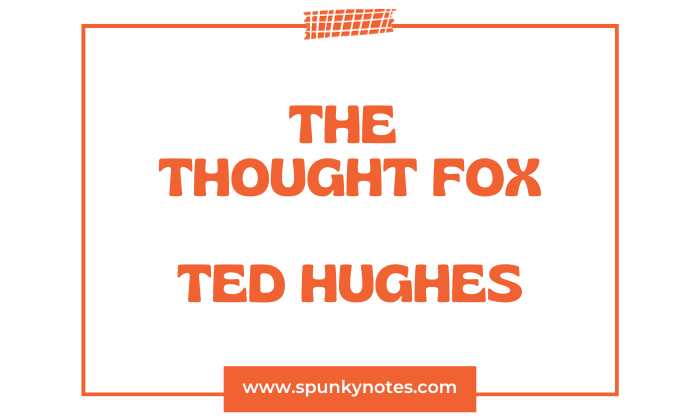
Q. Write an analysis of The Thought Fox, a poem by Ted Hughes.
“The Thought-Fox” is a well-known poem by Ted Hughes, first published in his debut collection, “The Hawk in the Rain,” in 1957. The poem comprises 24 lines, divided into six quatrains (four-line stanzas).
Analysis of The Thought Fox
Stanza 1
I imagine this midnight moment’s forest:
Something else is alive
Beside the clock’s loneliness
And this blank page where my fingers move.
I imagine this midnight moment’s forest
The poem begins with the speaker, presumably the poet, invoking the image of a forest at midnight. It is a metaphor for the mind or imagination in a state of potential, filled with darkness and possibilities. The mention of midnight implies a time of solitude conducive to creativity.
Something else is alive
This line introduces a sense of anticipation or the presence of an unseen entity. It is as though, in the stillness of the imagined forest and the midnight hour, the poet senses the stirrings of an idea or inspiration.
Beside the clock’s loneliness
The ticking clock is personified, which highlights its loneliness and separation. It could symbolize the solitary nature of the creative process. The ticking clock may symbolize the passing of time and the poet’s struggle to catch fleeting thoughts.
And this blank page where my fingers move.
The blank page is a powerful image representing potential and the yet-to-be-realized poem. The poet’s fingers across this page suggest the beginning of creation, the initial steps of transforming thought and imagination into written words.
Literary Devices
Imagery: “Midnight Moment’s Forest” paints a picture of a night-time forest, helping the reader visualize the scene.
Personification: The clock is described as lonely, giving it a human emotion to emphasize the quietness and isolation of the moment.
Contrast: The aliveness of something unknown is contrasted with the inanimate objects like the clock and the blank page, making the presence of this ‘alive’ thing more intriguing.
Metaphor: The metaphorical representation of the creative process involves the forest as the mind and the emergence of an idea or thought as ‘something else.’
Stanza 2
Through the window I see no star:
Something more near
Though deeper within darkness
Is entering the loneliness:
Through the window I see no star:
This line creates obscurity and perhaps a lack of inspiration or guidance. It suggests a deep darkness outside and possibly within the poet’s mind, reinforcing the sense of isolation.
Something more near
Though deeper within darkness
These lines introduce a paradoxical idea. While something is ‘more near,’ suggesting proximity or imminence, it is also ‘deeper within darkness.’
It indicates that it is not easily accessible or understandable. The poet senses an idea hidden in his subconscious or imagination. However, this idea is still within reach and close at hand.
Is entering the loneliness:
This line personifies the emerging idea, depicting it as beginning to infiltrate the poet’s solitude. The phrase ‘entering the loneliness’ conveys a sense of interaction between the poet and his internal world.
It suggests that the creative process is about to begin or has just started. It implies a connection between the poet and the deeper, darker aspects of his psyche, where creative ideas often germinate.
Stanza 3
Cold, delicately as the dark snow
A fox’s nose touches twig, leaf;
Two eyes serve a movement, that now
And again now, and now, and now
Cold, delicately as the dark snow
The comparison between the fox and dark snow implies an idea emerging subtly and gently. The use of cold and dark adds to the sense of solitude and mystery.
It evokes an image of something forming quietly and delicately, akin to snowflakes falling and settling without noise.
A fox’s nose touches twig, leaf;
This line brings sensory detail into the poem. The fox, symbolizing the poet’s thought or inspiration, is depicted as cautiously exploring its surroundings.
Touching the twig leaf suggests careful and delicate probing, similar to how a writer or artist tentatively explores ideas.
Two eyes serve a movement, that now
The focus on the fox’s eyes highlights attention and intention. The eyes guiding the movement signify the poet’s growing concentration and focus as the idea becomes more apparent. This line conveys a sense of purpose and direction in the creative process.
And again now, and now, and now
The repetition of now emphasizes the immediacy and fleeting nature of inspiration. It captures the ever-changing nature of the creative process.
It reflects the progression of thought moment by moment. Each ‘now’ could represent a moment of clarity or the development of an idea.
Stanza 4
Sets neat prints into the snow
Between trees, and warily a lam e
Shadow lags by stump and in hollow
Of a body that is bold to come
Sets neat prints into the snow
The fox’s footprints in the snow are like the poet’s thoughts taking shape. Just as the footprints make a path in the snow, the poet finds the right words to show his ideas clearly.
Between trees, and warily a lam e
Shadow lags by stump and in hollow
These lines further the imagery of cautious movement. It symbolizes the hesitancy and vulnerability in the creative process as the poet navigates through uncertain or unexplored aspects of thought and expression.
The shadow is an imperfect reflection of the fox, representing the initial form of ideas during development.
Of a body that is bold to come
This line contrasts with the earlier description of wariness. The ‘body that is bold to come’ suggests growing confidence in the emerging idea.
As the poet’s thoughts become more concrete, a sense of boldness and assertiveness takes shape. When a poet fully realizes his idea, it takes form and asserts its presence in his consciousness.
Stanza 5
Across clearings, an eye,
A widening deepening greenness,
Brilliantly, concentratedly,
Coming about its own business
Across clearings, an eye,
In the context of “The Thought Fox,” this line could symbolize the initial spark of an idea or inspiration in the poet’s mind. The “clearings” may represent open spaces in the poet’s imagination.
The “eye” could symbolize the emerging focus or clarity of a new idea.
A widening deepening greenness,
This line might represent the development and enrichment of the initial idea. The imagery of “widening deepening greenness” suggests growth and expansion.
It indicates how a simple thought or idea in poetry can grow, deepen, and evolve into something more complex and profound.
Brilliantly, concentratedly,
Here, Hughes could convey the intensity and focus that come with the creative process. The adverbs “brilliantly” and “concentratedly” suggest a focused engagement with the emerging idea, reflecting the poet’s deep immersion in the act of creation.
Coming about its own business
This line suggests that the idea or inspiration has a life. The emerging poem or idea in a poet’s mind has an inherent trajectory, like a fox that moves with intent and purpose.
Both follow a natural course that guides their actions. It implies that the creation process is not entirely under the poet’s control, but rather, the idea evolves and develops organically.
Stanza 6
Till, with a sudden sharp, hot stink of fox
It enters the dark hole of the head.
The window is starless still; the clock ticks,
The page is printed.
Till, with a sudden sharp hot stink of fox
This line marks the climax of the poem. The sudden, sharp, hot stink of fox captures the moment of creative inspiration fully crystallizing in the poet’s mind.
Using olfactory imagery (sense of smell) creates a striking and unusual effect. It suggests the powerful, almost tangible presence of the idea as it finally takes on a definitive shape.
It enters the dark hole of the head.
Here, the metaphorical fox (representing the poetic idea) finds its home in the poet’s mind (the dark hole of the head).
This line symbolizes the moment when inspiration is internalized and becomes a part of the poet’s conscious thought, ready to be transformed into poetry.
The window is starless still; the clock ticks,
These details ground the poem back in the reality of the poet’s surroundings. The starless window suggests the darkness of the night, indicating that the external world remains unchanged by the internal creative event.
The ticking of the clock implies the passing of time. It suggests that the inspiration occurred in a timeless space, separate from the regular flow of time.
The page is printed.
This final line is decisive and conclusive. From the imagination and internal world of the poet, the idea has now been made manifest in the physical world as a written poem.
‘The page is printed’ signifies the completion of the creative process, where the initially elusive and intangible thought, like the fox, has been captured in the form of written words on a page.

